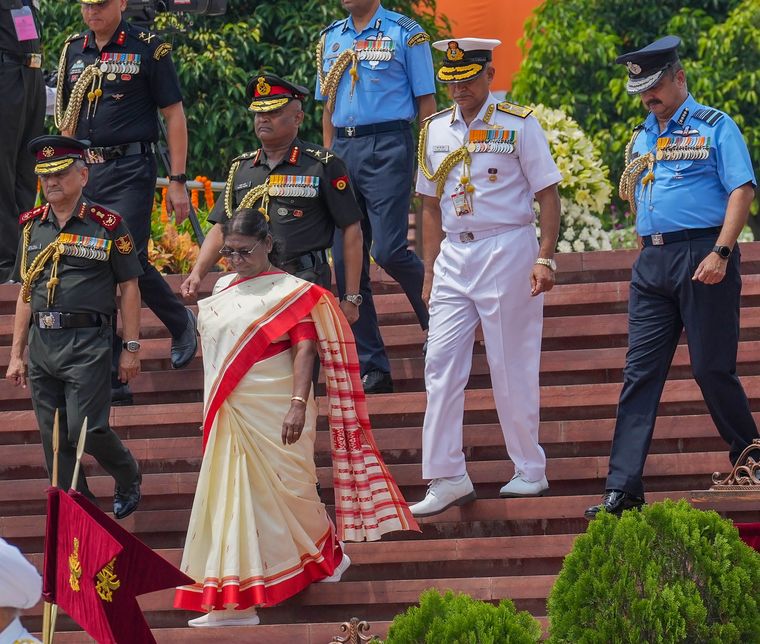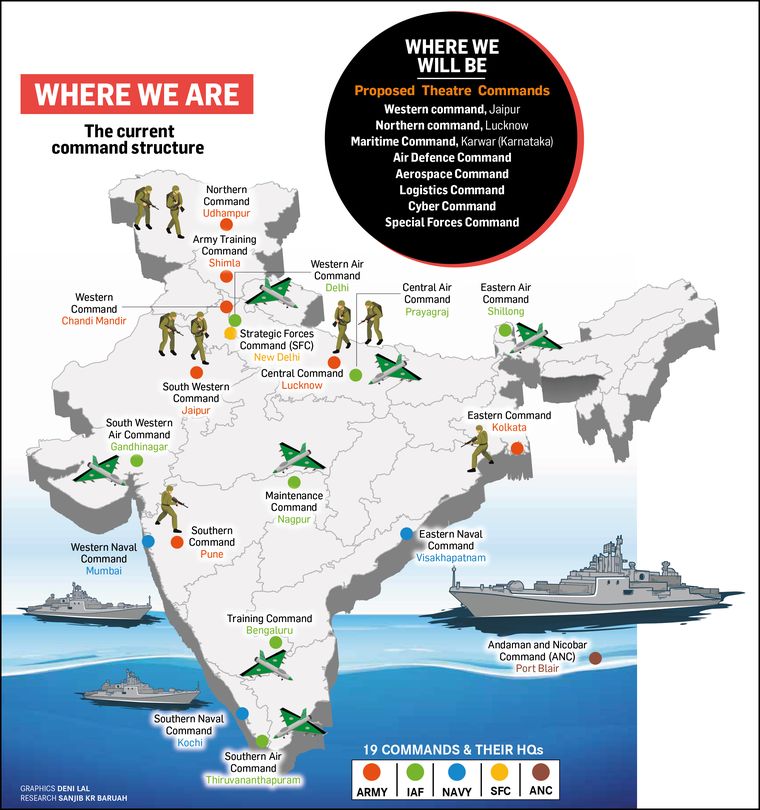Perched at about 11,000 feet, Drass―Ground Zero of the 1999 Kargil War―is touted as the world’s second coldest inhabited place. One would have wondered what a posse of Indian Navy’s marine commandos (MARCOS) would be doing in the mountainous cold desert on this year’s Kargil Vijay Diwas event on July 26. After all, Drass is thousands of kilometres from the nearest coast.
Times are changing. The functional military boundaries of land, sea and air are fading. Brigadiers and colonels are being sent to train with the Navy and the Air Force, while senior Navy and IAF officers are training with the Army. The department of military affairs (DMA), created on the first day of 2020, is working to promote the culture of theaterisation. Cross-postings are the order of the day. The idea is to integrate units of all three services in a single theatre under a common commander to enhance operational efficiency. The Chinese did it in 2016, the US and most major militaries had done it a long time ago. Even the Pakistanis are reported to be on the job.
India, despite some initial setbacks, has kickstarted the process to set up theatre commands, which involves jointness and integration of the disparate war-fighting units. The Inter-Services Organisation (Command, Control and Discipline) Bill, 2023, a key prerequisite for theatre commands, got parliamentary approval on August 8. It awaits presidential assent now.
The bill seeks to enable an officer of an inter-services organisation―the actual commander of a unit, ship or establishment―to initiate disciplinary or administrative action over the personnel appointed, deputed, posted or attached to the organisation, irrespective of their parent service. Currently, Army personnel are governed by the Army Act, 1950, IAF personnel by the Air Force Act, 1950, and Naval personnel by the Navy Act, 1957. Theaterisation aims to replace the existing functional commands with theatre commands, giving a single commander in a designated zone authority over all the assets and resources of all three services stationed in that particular zone.
India now has 19 commands, including 17 single-service commands based on operational and geographical needs. The Army has six operational commands and one training command; the IAF has five operational commands, a training command and a maintenance command and the Navy has three commands. Then there are two additional commands―the tri-services command located at the Andaman and Nicobar Islands and the Strategic Forces Command. In the eventuality of an all-out conflict with China, at least seven commands will be involved in defensive and offensive operations. On the other hand, China’s western theatre command alone will be taking on Indian forces. The advantages of a cohesive and integrated unit in war-fighting cannot be overemphasised.
Two game-changing measures―the Agniveer system of recruitment that began in 2022 and the theaterisation process―are set to alter the structure, shape and size of India’s fighting forces like never before. Theaterisation was, however, jinxed from the very beginning. It hit the first obstacle in the form of strident opposition from the IAF almost immediately after the process was initiated by the country’s first chief of defence staff, General Bipin Rawat. His statement, describing the IAF’s role as a “supporting” one, did not help. It drew an agitated retort from the then IAF chief, Air Chief Marshal R.K.S. Bhadauria (retd). “Air power has a huge role to play. In any of the integrated battle areas, [the role of the Air Force] is not about support alone, and there are a whole lot of things that go into any air power plan,” he said. Besides its narrow asset base of aircraft, the IAF had concerns over the role, asset division and consequent allocation. It was also worried about the structure of the theatre commands and their leadership.
The theaterisation plan suffered another blow with the sudden demise of General Rawat in a helicopter crash on December 8, 2021. The crucial post of the CDS remained vacant for about ten months until the appointment of General Anil Chauhan on September 30, 2022.
The Galwan valley incident on the intervening night of June 15 and 16, 2020, meanwhile, was a mixed blessing for the theaterisation process. It was here in the cold, hilly deserts of eastern Ladakh that a primitive style hand-to-hand combat with stones, steel rods and improvised spiked clubs broke out between Indian and Chinese troops. It claimed at least 24 lives, while hundreds were injured. The combatants were not to know that their actions would result in far-reaching changes for the Army as far as its operational, tactical and strategic posturing against China was concerned. The incident lent urgency to the theaterisation process, but at the same time, it thwarted the pace of ideation and execution as the military establishment became preoccupied in a mammoth effort to redeploy more than 50,000 soldiers along with heavy war-like equipment in the difficult and high-altitude areas along the border with China.
Admiral Karambir Singh (retd), who was Navy chief during the Galwan incident, said the conflict reinforced the necessity of theatre commands. “Even during the crisis, the process of discussion and study of theatre commands continued. The Air Force, however, continued with its obstruction of the concept.”
Theaterisation of military commands was not a foreign idea for Indian forces. It first came about in the aftermath of the Kargil conflict when Indian soldiers were sent out to expel intruders comprising Pakistani soldiers and irregulars perched on the icy heights of Tiger Hills, Tololing Ridge and other dominating features that overlooked National Highway number 1 in Ladakh. The Pakistani domination of the Drass section of NH 1 would have blocked Indian access to Ladakh and also to the all-important Siachen glacier.
The theaterisation idea gained traction in the Kargil Review Committee set up in 2000, and it received a further boost in the form of a recommendation in the Group of Ministers’ report (2001) on Kargil. The report envisaged a joint command in the place of the existing Andaman Nicobar Command as the “crucible for future joint commands”, similar to theatre commands.
In 2005, the discussion on theatre commands was started by the Headquarters Integrated Defence Services when Admiral Arun Prakash was the chairman of the chiefs of staff committee. A year later, he wrote to the defence minister that theatre commands were the “end point of jointness”. The discussion continued thereafter, and it was most firmly stated in the report of the Shekatkar Committee (2016), which was constituted to recommend measures to enhance combat capability and rebalance defence expenditure of armed forces.
In response to the 73-day-long Doklam standoff with China (2017), India had undertaken a massive exercise called ‘Himvijay’ in October 2019. It had a few elements resembling theaterisation. A central feature of Himvijay, which took place in Arunachal Pradesh’s forbidding heights, was battle formations called Integrated Battle Groups (IBGs). The IBGs were slightly bigger brigade formations that deployed a mix of infantry, artillery, tanks, air defence, attack helicopters and logistics units. So, in a way, the effort at ‘jointness’ had already taken off.
If further push was needed, the Galwan incident provided that in ample measure. Admiral Singh said Galwan was an inflexion point that sharpened India’s competitive instincts vis-à-vis China. “We did not let China sandbox the Line of Actual Control (LAC) issue and responded to the provocation with diplomatic, information, military and economic elements. The Navy adopted an aggressive stance against the Chinese navy in the Gulf of Aden and Chinese merchant vessels in the Indian Ocean Region. This prompted the Chinese to get worried and raise their concern in successive WMCCs (Working Mechanism for Consultation and Coordination on India-China Border Affairs).”
General Manoj Naravane (retd), who was the Army chief during the Galwan crisis, said that although the threat from Pakistan had been going down and China had become India’s primary adversary, the military establishment was a little reticent in admitting the change. “Even after Doklam, we were still a little bit hesitant to go all out and say that China was the main threat,” he said. “But Galwan changed that. Now we no longer shy away from saying that China is our enemy number one. The crisis in eastern Ladakh has brought to the fore that we have to deal with China head on, and from a position of strength. Diplomatic niceties and wording it in acceptable terms―so that we don’t annoy China―have gone out of the window.” The theaterisation process could help add meat to India’s efforts to deal with this new strategic reality.
While the final definitive contours of the theaterisation architecture is yet to be finalised, various models are already being discussed. As CDS, General Rawat had hinted at four commands―a western theatre command to face Pakistan, a northern command for the China border, a maritime theatre command and an island command, which is already functional as the Andaman & Nicobar Command. He also considered an aerospace command and a cyber command. A subsequent model focused on four integrated commands―the maritime theatre command, the air defence command, the eastern theatre command and the western theatre command.
Another model under consideration is a four theatre set-up comprising the northern theatre command (to face China), western theatre command (for the Pakistan border), the southwestern command and the southeastern command for the western part and eastern part of the Indian Ocean, respectively.
At the moment, not much details about the theaterisation effort are available in the public domain, but the process would definitely have to address key questions like clearly defining an appropriate hierarchical chain of command, the relationship between service headquarters and the theatre commands and addressing training needs for the wide variety of roles that theaterisation would result in. The sheer difficulty of promoting the process of theaterisation is fraught with challenges and negotiating those will test the military-bureaucratic processes to the hilt. Evidently, the need for quick resolution is already being challenged by the complexity of the process.




